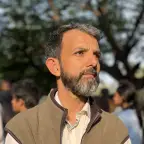“India is changing,” a topic not new to discussions. However, certain transformations have taken place in the country that had escaped my radar until now. I won’t delve into the pros and cons, but changes become more apparent when revisiting familiar places or faces after a hiatus.
Like meeting an old friend and realizing they’ve grown vertically, or observing mid-aged relatives growing horizontally, revisiting these spaces after a few years magnifies the changes. Passing by AIMS, Delhi, recently, I couldn’t believe my eyes — the entire place had changed for the better, adorned with new flyovers. While Delhi, the drawing room of India, often gets special attention, I personally prefer the Parisian approach of building underpasses for their aesthetic appeal. Yet, the practicality and cost of flyovers often prevail, especially in a country prone to monsoon rains.
Credit goes to the Election Commission for banning political graffiti on walls, sparing them from being adorned with symbols like “hands,” “lotus,” or various animals. However, these walls now host posters ranging from IIT coaching (ISO certified) to shoe advertisements.
A routine haircut is a must for me upon arriving in and departing from India. The price is a significant advantage, but the main draw is the quality. Accompanying SK to the nearest hairdresser, I noticed the trend of salons adopting fashionable names like “Copper Clips” or “Silver Scissors.” A simple haircut that used to cost my dad 15 rupees is now Rs 60 for me, but the absence of air conditioning prevents it from being called a “Men’s parlour.”
Venturing beyond these observations, my gaze fixated on a 19/21-year-old boy, quite overweight, undergoing a pedicure. Instead of investing in pedicures, perhaps joining a gym or engaging in physical activity would be a more beneficial choice. This might be a personal perspective, but it raises questions about the values associated with money and luxury.
Among other trends, I noticed that being part of the affluent class in India often means being overweight, particularly for men, with a significant belly. This is attributed to a diet rich in food, minimal physical activity, and reliance on domestic help for daily chores. It’s time for educated Indians to reevaluate the values linked with wealth and luxury.
Furthermore, the meteoric rise in the number of mobile phone users in the country is striking. From vegetable sellers and helpers to higher classes, everyone is engrossed in their small e-gadgets, engaged in lengthy conversations. It seems that the day is not far when more people communicate over phones than in person, marking a significant shift in social dynamics.
Read Next
Changing face of India
2006-03-15-changing-face-of-india
Tujh bin….
2006-03-06-tujh-bin

